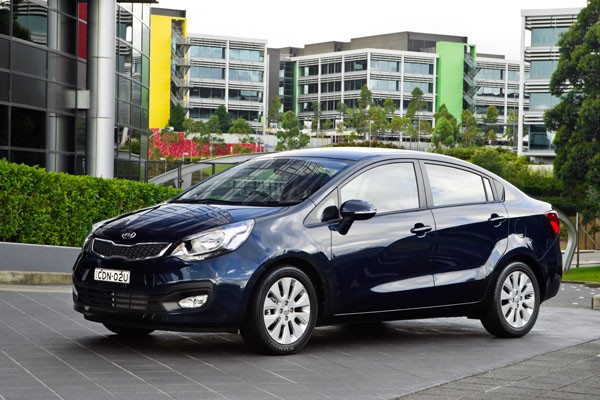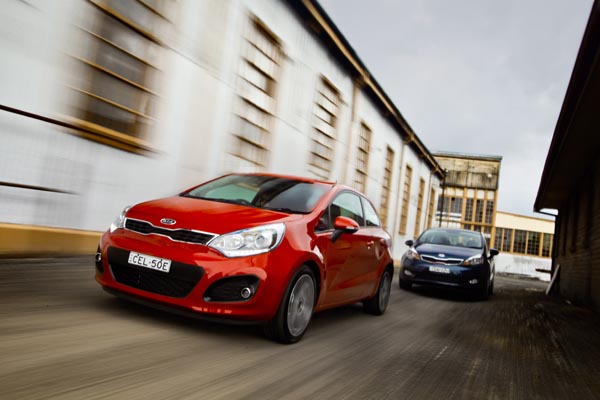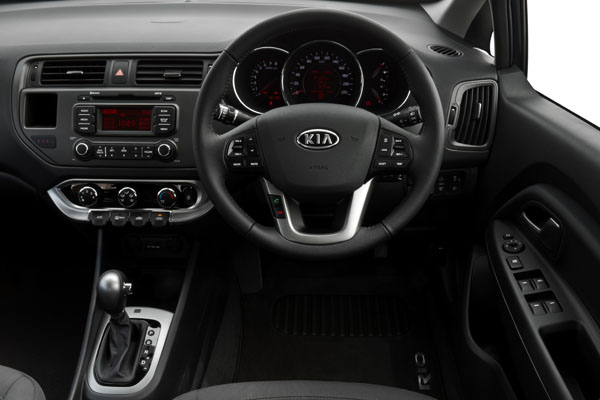 Kia has just clicked in the final pieces of the new Rio jigsaw with the coming of the three- and four-door models.
Kia has just clicked in the final pieces of the new Rio jigsaw with the coming of the three- and four-door models.
The fourth-generation Rio had already set a specification benchmark in the light passenger vehicle segment with its five-door hatchback which came to Australia late last year.
Now comes a choice of three and four-door variants giving the Korean car maker the rare distinction of having three body shapes in this market.
 With the choice of two engines, mated with either a six-speed manual or six-speed automatic incorporating a manual function in the Si, SLi and SLS specification and either a six-speed manual, and either a six-speed manual or four-speed automatic in the entry-level S spec.
With the choice of two engines, mated with either a six-speed manual or six-speed automatic incorporating a manual function in the Si, SLi and SLS specification and either a six-speed manual, and either a six-speed manual or four-speed automatic in the entry-level S spec.
The last-mentioned base model S comes with a 1.4 litre MPi DOHC, continuously variable valve timing four-cylinder engine producing 79 kW of power at 6300 rpm and 135 Nm of torque at 4200 revs – 9 kW and 10Nm more than the 1.4-litre motor it replaces.
 Star billing, however, goes to the 1.6-litre Gamma GDi (for gasoline direct injection) four-cylinder power plant, which puts out 103 kW at 6300 rpm and 167 Nm at 4850 rpm, 13 per cent more power than a conventional 1.6 Gamma multi-point petrol injection unit.
Star billing, however, goes to the 1.6-litre Gamma GDi (for gasoline direct injection) four-cylinder power plant, which puts out 103 kW at 6300 rpm and 167 Nm at 4850 rpm, 13 per cent more power than a conventional 1.6 Gamma multi-point petrol injection unit.
Fitted to the mid-range Si and top-spec SLS three-door, and Si and SLi five-door models, the 1.6 Gamma GDi is the smallest Kia engine to benefit from gasoline direct injection and can hit 100km/h from zero in 10.2 seconds (manual) and 10.3 seconds (automatic) on the way to a top speed of 190 km/h.
 Fuel consumption on the combined cycle is put at 5.6 litres per 100 kilometres and 6.1 L/100 km respectively.
Fuel consumption on the combined cycle is put at 5.6 litres per 100 kilometres and 6.1 L/100 km respectively.
Matching the five-door hatch in its striking looks, the new three-door shares the same dimensions – 4045 mm long, 1720 mm wide, 1455 mm tall with a wheelbase of 2570 mm.
The three-door S becomes a way of introducing the Rio and sets the price standard at $15,290, while the SLS takes on the ‘hero’ role with all the features of the top-of-the-range five-door SLi, including climate control air-conditioning, Bluetooth connectivity and radio/CD with MP3, Aux, iPod and USB jacks. All controls, plus cruise control, are to hand on the steering wheel.
 Added to this are daytime running lights, 17-inch alloy wheels, projector-style front headlamps, static cornering lights, automatic light control and an enhanced brake package.
Added to this are daytime running lights, 17-inch alloy wheels, projector-style front headlamps, static cornering lights, automatic light control and an enhanced brake package.
The three-door SLS goes beyond the five-door with climate control with defog, rain sensing wipers, push-button engine start/stop with keyless entry and leather upholstery. Price is $21,990 in six-speed automatic, the same as the five-door SLi.
The new Rio four-door is aimed at the more conservative, and probably more mature, buyer with the need for larger cargo carrying capacity than the hatchback offers.
In looks, it has its own interpretation of the Kia corporate branding with a new-look radiator grille boasting understated chrome trim and distinctive headlamps. The Kia logo itself is positioned above the grille.
The front overhang is shorter than the previous model by 35 mm, the roofline has been lowered and there’s a bigger body-to-glass ratio. An increased beltline angle (from 2.5 to 4.9 degrees) emphasises the car’s wedge shape giving it a sporty stance.
Longer by 115 mm, wider by 25 mm and lower by 15 mm, with a wheelbase increased by 70 mm to 2570 mm, the sedan spoils occupants with more room, as well as offering more boot space – 389 litres, better by 14.4 per cent.
Headroom is generous too despite an overall height of 1455 mm, making it one of the lowest cars in the Kia catalogue. Aerodynamics are impressive with a drag co-efficient of Cd 0.29.
The four-door comes in Si trim and features the 1.6 litre Gamma GDi engine, mated either to a six-speed manual or six-speed automatic transmission for $19,690 and $21,690 respectively.
Active and passive safety are no longer solely in the realm of big and expensive vehicles. Buyers demand superstar crash safety in even the cheapest runabouts. The new Rios are no exception, carrying six airbags and electronic stability control across the range.
An all-new body shell makes use of more high-strength steel than its predecessor. Further strengthening all round from side and cross-members to dashboard bulkhead adds strength and rigidity.
Brakes consist of discs all round (256 mm/262 mm) on S and Si models and 280 mm/262 mm (SLi and SLS). All new Rios have hill start assist, electronic stability control, ABS anti-skid brakes with electronic brake force distribution and emergency brake assist.
Kia Australia engineers had a large input into the new Rio’s ride and handling, shaking down each model in exacting conditions over 2000 km on the same stretch of road near the Hunter Valley. They also put them up against rivals in the light vehicle segment. Data was relayed to Kia HQ in Korea and modelling applied to all Rio variants. I can vouch for the veracity of the tests as the new three and four-doors were given to the motoring media to try out over the same road.
The intensive work was worthwhile, the new three and four-door Rios taking everything in their stride. The only letdown was excessive tyre noise on some road surfaces.
With the addition of three and four-door models, the new Rio range – all covered by the maker’s five-year unlimited kilometre warranty has something for everybody.
The complete Kia Rio model range, with prices (excluding government and dealer charges) is:
Rio S 1.4-litre three-door hatch: $15,290 (manual), $17,290 (automatic)
Rio SLS 1.6-litre three-door hatch: $19,990 (manual), $21,990 (automatic)
Rio Si 1.6-litre four-door sedan: $19,690 (manual), $21,690 (automatic)
Rio S 1.4-litre five-door hatch: $16,290 (manual), $18,290 (automatic)
Rio Si 1.6-litre five-door hatch: $18,990 (manual), $20,990 (automatic)
Rio SLi 1.6-litre five-door hatch: $19,990 (manual), $21,990 (automatic)










